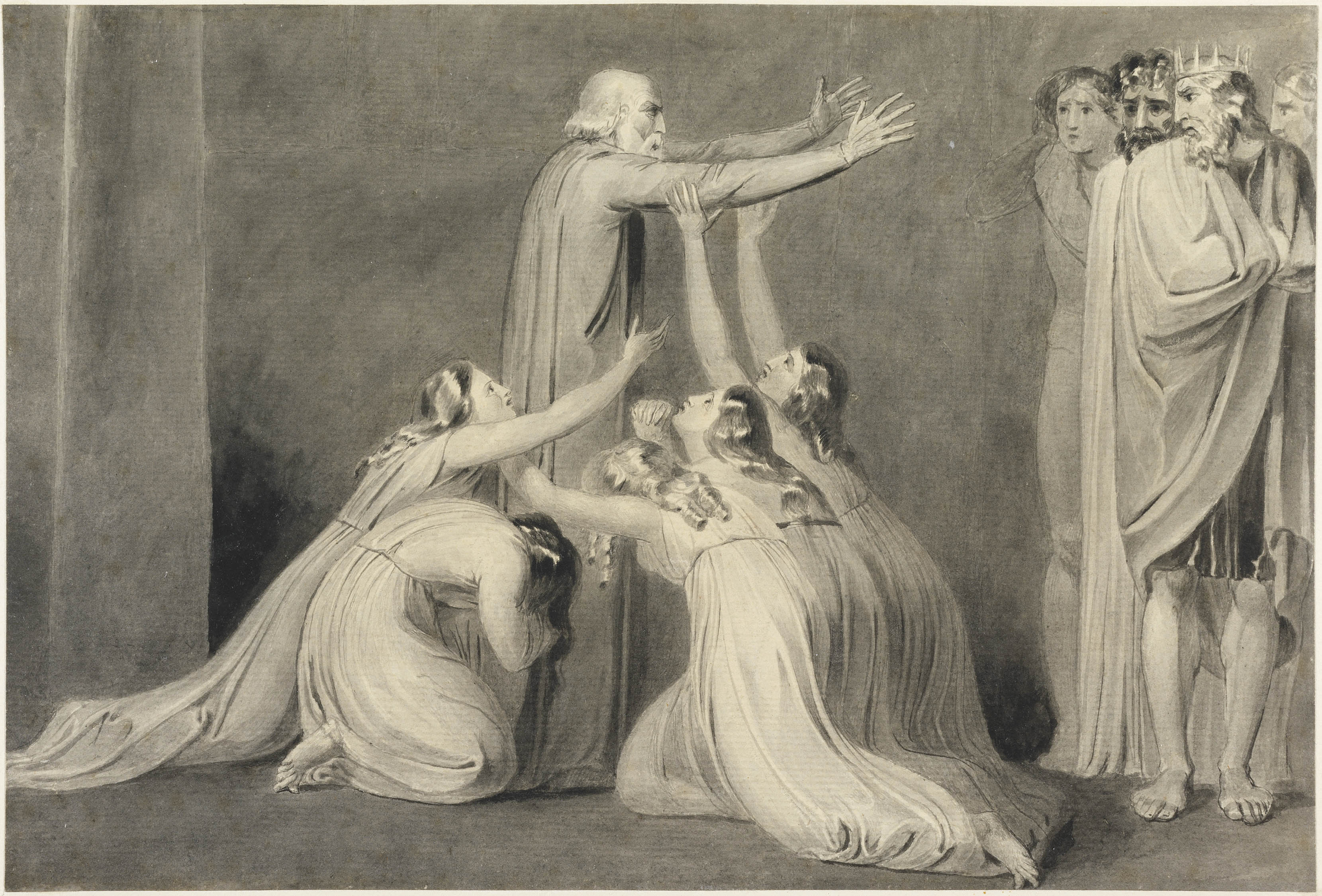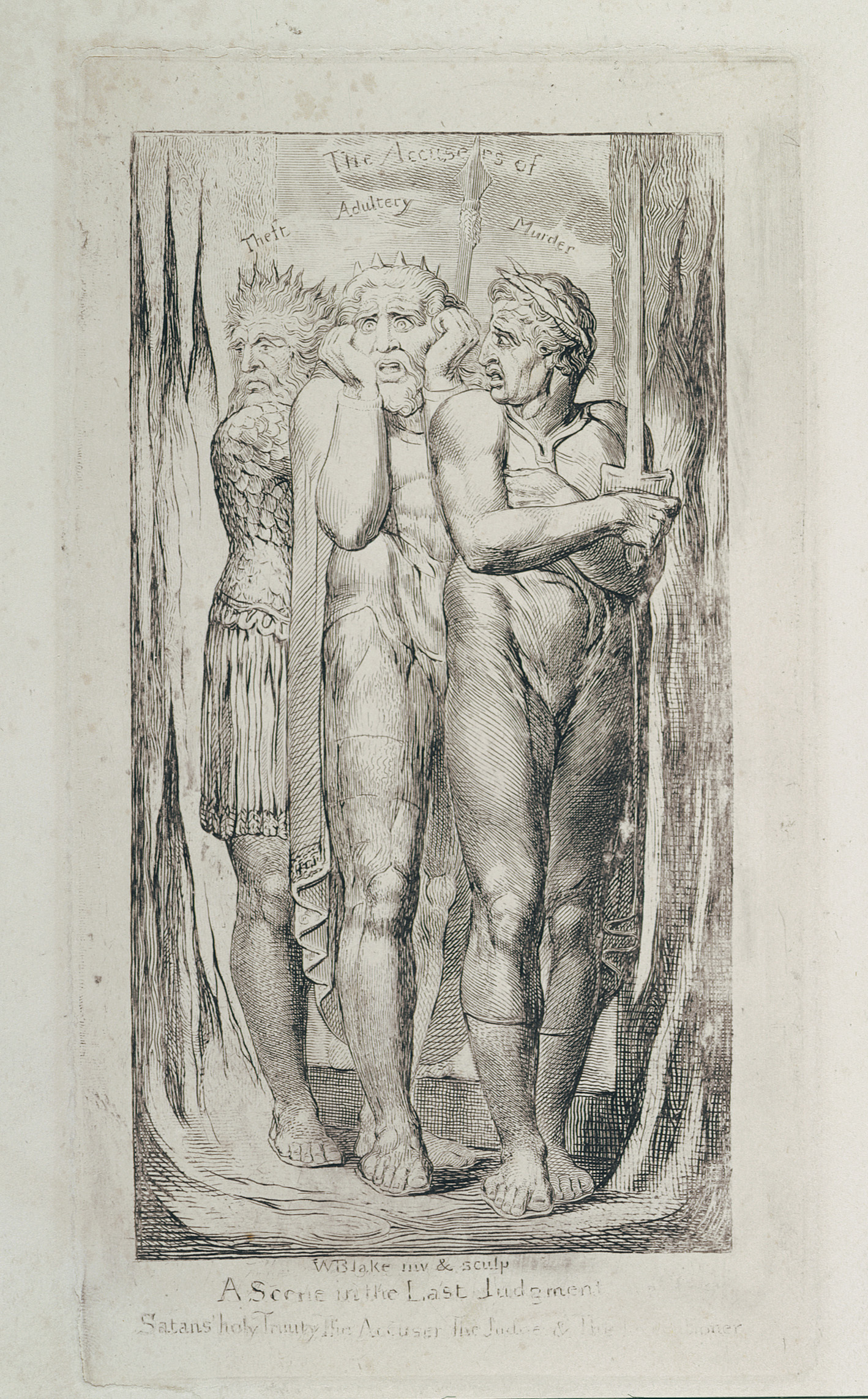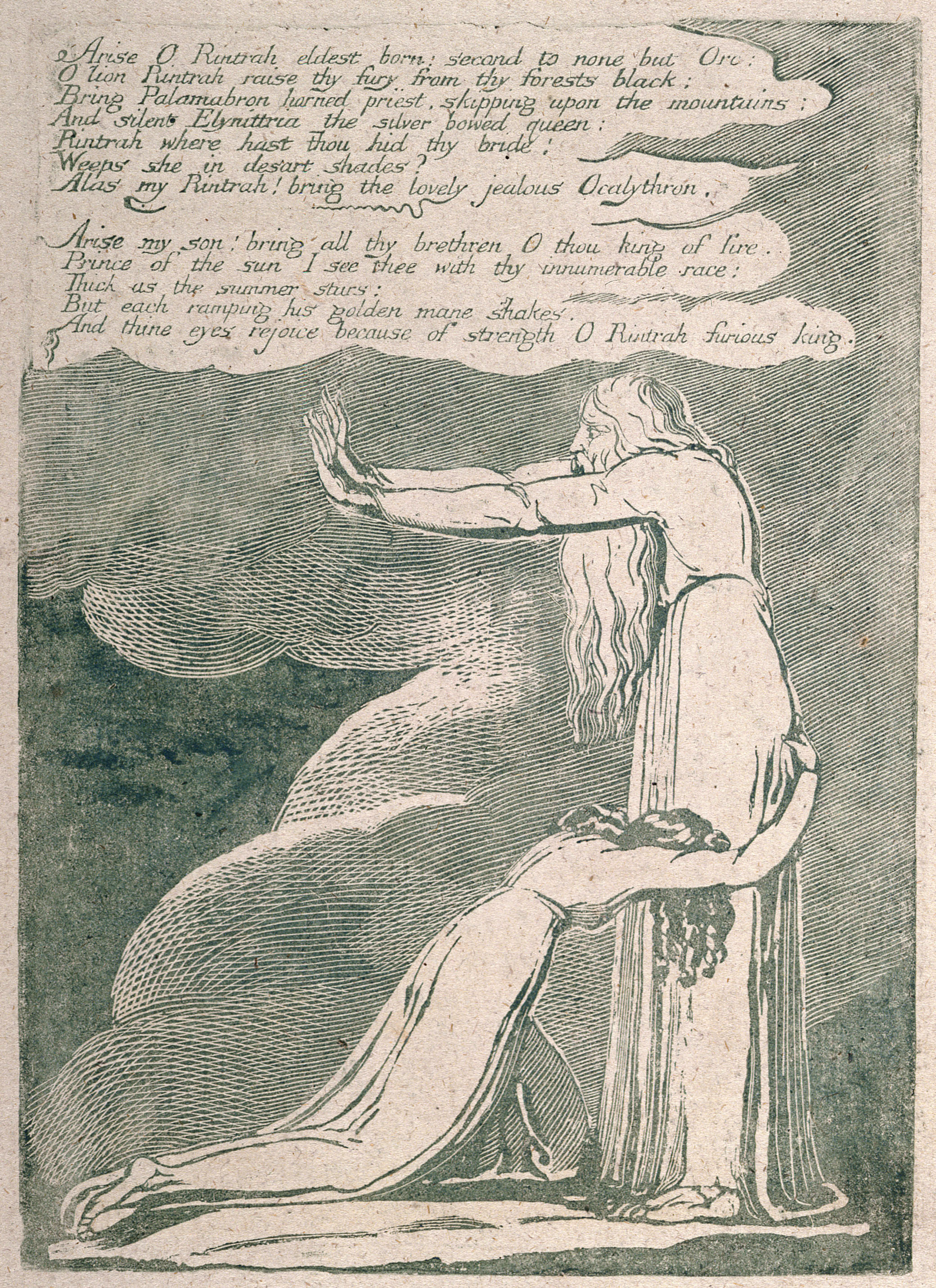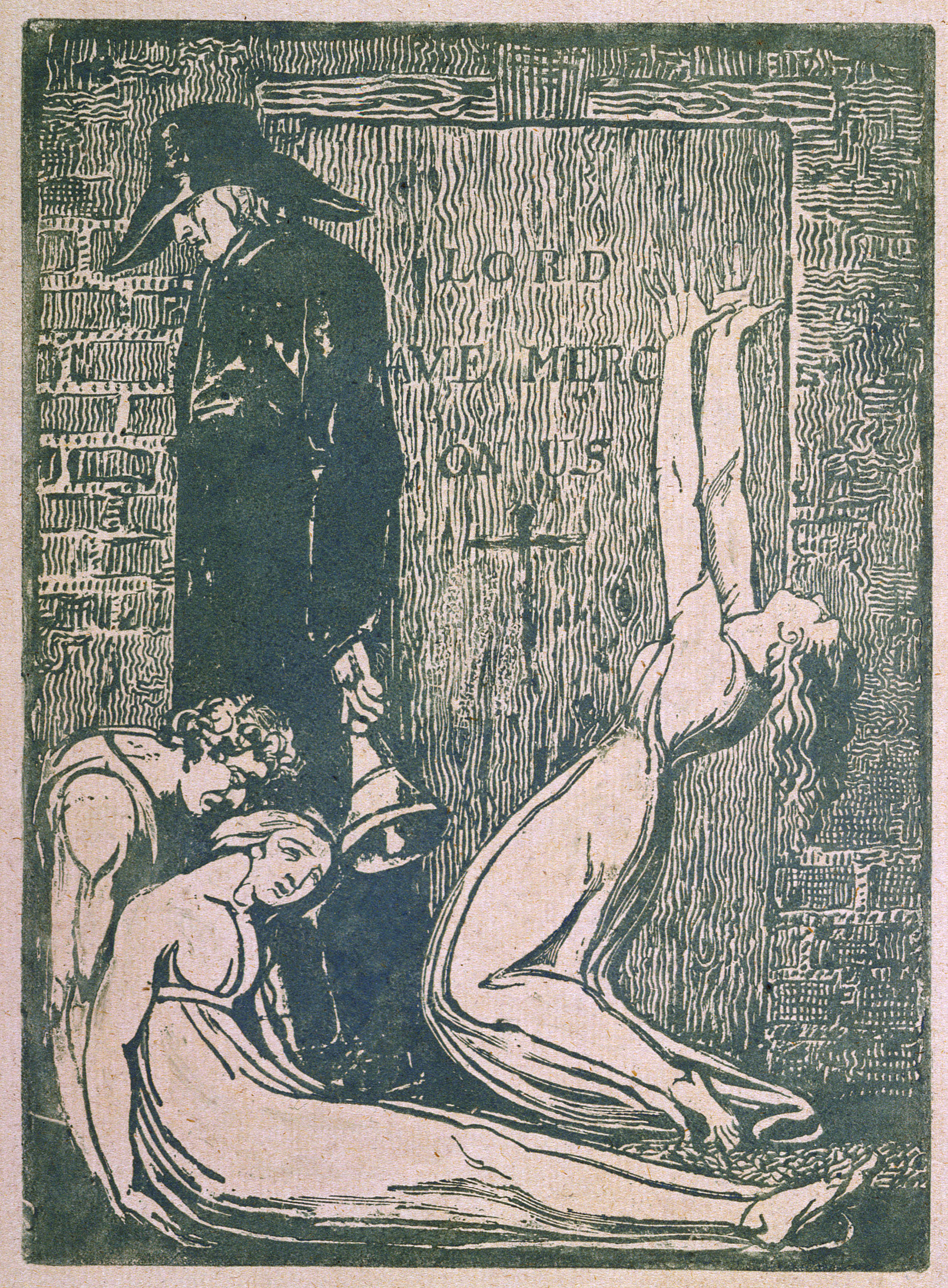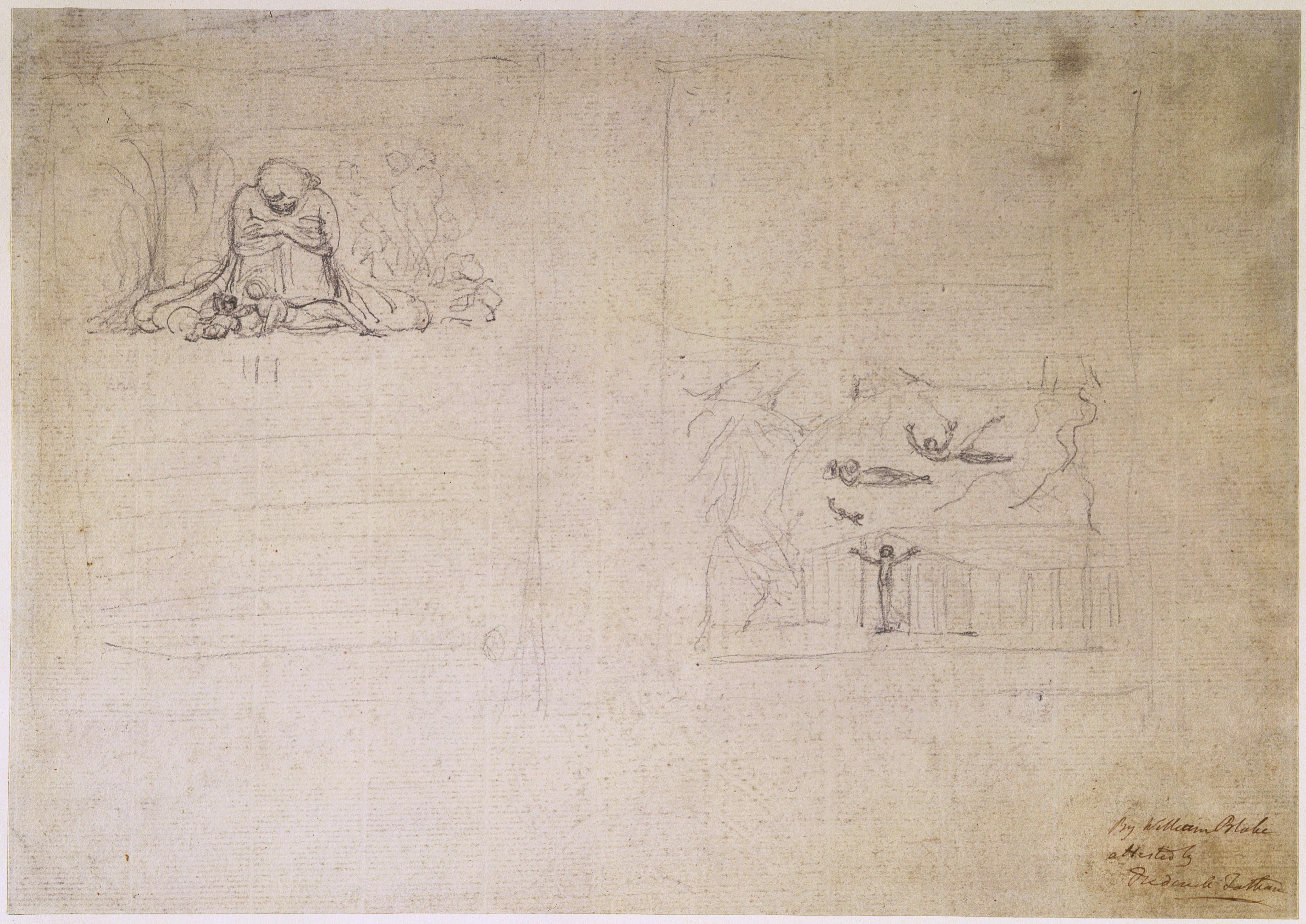article
begin page 128 | ↑ back to topFrom Sketch to Text in Blake: The Case of The Book of Thel
There is a long and honorable prophetic tradition of spiritual dictation, from the Bible through Boehme, Milton, and Swedenborg, in which William Blake clearly participates. According to this tradition, the Lord or Muse “govern[s] . . . my song,” as Milton wrote in Paradise Lost Book VII, and Blake wrote, probably of Jerusalem:
I have written this Poem from immediate Dictation twelve or sometimes twenty or thirty lines at a time without Premeditation & even against my Will.Blake was also proud of his graphic consistency:
(Letter of 25 April 1803)
Reengraved Time after Time[,]He insisted upon the importance, the inviolability of the firm, bounding outline, and his disciple Samuel Palmer wrote on one of Blake’s sketches that they were the “first inventive lines—from which he was always most careful not to depart.”1↤ 1 Blake Records (1969), p. 494 fn. 5. All quotations are from William Blake’s Writings (Oxford: Clarendon Press, 1978). The Thel sketch was made public so recently that no edition of Blake in print refers to it; the only printed references known to me are in David Bindman, Blake as an artist (1977), pp. 63-64 and pl. 52, and Martin Butlin, William Blake: [Catalogue of an exhibition at the] Tate Gallery [9 March-21 May 1978], p. 4 (including a reproduction). A version of this paper entitled “Editing Blake: From Sketch to Text” was delivered orally at the Modern Language Association meeting on Editing the Romantics in December 1978 in New York. However, impressive though this testimony is from Blake’s disciple and from Blake himself, the evidence of the drawings belies it. He did often alter his “first inventive lines” when he came to etch his designs. I wish to cite some of these developments in his designs for his works in Illuminated Printing, especially for The Book of Thel.
Ever in their Youthful prime
My Designs unchangd remain. . . .
Sometimes the relationship of Blake’s preliminary sketch to the etched and printed version is simple and straightforward, as in the sketch for Jerusalem pl. 26 (illus. 1). The chief graphic differences between this and the printed version are the shading behind the woman to the right and the look of anguish on the face of the man, which is revised in the etching to a baleful look. The most significant alteration in the printed form is the lettering added to identify the woman as Jerusalem and the man as Hand, and the vertical quotation:
Such visions have appeared to meThe verse is plainly an afterthought, perhaps inspired by the design itself. Notice that the sketch and the etching face the same way round; unless there was an intermediary reversed sketch, Blake must have copied the design backwards on the copper so that it would print the right way round. The normal engravers’ practice was to make a true size squared version on paper which could be transferred directly to the copper, perhaps by some form of tracing. Blake certainly followed this method with his commercial engravings after the designs of other men, but he seems to have transferred his own designs much more freely to copper, and parts of the Job engravings, at least, were first composed directly on the copper rather than on paper.
As I my ordered race have run[;]
Jerusalem is named liberty
Among the sons of Albion[.]
The second example, from Jerusalem pl. 51, is a good deal more complex. In the final version as printed, there are three figures who form a kind of Satanic trinity; on one pull they are labeled Vala, Hyle, and Skofield (Vala with the crown and Skofield with the chains). So far as these figures are concerned, the chief differences from the sketch are the flames billowing across the page and the reversal of the whole design. The dramatic difference in the sketch (illus. 2) is in the extraordinarily bestial crawling man with shaggy pelt and electrified hair who appears beside the figure in chains—at our left here, though he would have been at the right in Jerusalem. What are we to make of a Satanic quaternity? Notice also that the design is now the wrong shape for the Jerusalem page—too broad for its height. Clearly one of these almost equally-spaced figures would have to be eliminated, and you can see from the vertical lines to left and right of the figure in chains that the leaf has been folded to try out various possibilities, obscuring first one figure at the left and then two. Perhaps at one point Blake thought of Skofield as a Nebuchadnezzar figure reduced to eating grass like the beasts of the field. Or perhaps the shaggy beast is another giant figure entirely.2↤ 2 He is identified as Hand by Morton Paley, William Blake (1978), p. 68, and as Albion by Detlef W. Dörrbecker, “That Man Be Separate from Man: Überlegungen zu einer Zeichnung William Blakes,” Jahrbuch Hamburger Kunstsammlungen, 22 (1977), 101-26. Whatever his significance, he adds a fascinating dimension to the problem of interpreting Blake’s original intention for Jerusalem pl. 51.
A much more perplexing design is the one which appears in various forms in Tiriel, The Marriage of Heaven and Hell, and Europe, and which begins as a design by begin page 129 | ↑ back to top someone else entirely. The design originates in a sketch known as “The Approach of Doom” (illus. 3) by Blake’s favorite brother, Robert, who died in his arms in February 1787. It is an undistinguished design, chiefly remarkable for the horror expressed by the figures at left as they gaze at the empty darkness on the right hand side of the page. William Blake’s very rough reversed etching after it (illus. 4) is chiefly remarkable for the variety of techniques used to represent shading. The etching is technically fascinating but visually dull.
The visual idea is much more interesting when it is adapted in Blake’s eighth design for his manuscript poem Tiriel (illus. 5). The huddled group of six or more figures looking left in horror has been reduced to four, the most prominent of whom are a crowned king in a mantle and a black-bearded man at his shoulder. But now we see the cause of their horror; their father Tiriel, surrounded by a garland of five weeping, gesticulating
At the fathers curseThe design clearly echoes the text quite faithfully, and the words make it plain that the threatened horror is the pestilence. begin page 130 | ↑ back to top
The earth trembled[,] fires belched from yawning clefts
And when the shaking ceast a fog possesst the accursed clime[.]
The cry was great in Tiriels palace[;] his five daughters ran
And caught him by the garments weeping with cries of bitter woe[.]
. . . in the morning Lo an hundred men in ghastly death[,]
The four daughters stretchd on the marble pavement silent all
falln by the pestilence. . . .
The horrified onlookers appear once more in a design of 1793 labeled “Our end is come” or, in a later version, “Satans holy Trinity[:] The Accuser The Judge & The Executioner” (illus. 6). One copy of it is used as an integral frontispiece to The Marriage of Heaven and Hell. Clearly these flaming bureaucrats see themselves accused and their punishment near. They seem unmistakably the heirs of Tiriel’s sons in the drawing of four years earlier.
There is one final transmogrification of this protean design. Tiriel cursing with his hands outstretched and his daughters at his knees is closely echoed, reversed, in Europe pl. 8 of 1794 (illus. 7). The design seems to represent what the text on pl. 12 calls “Albions Angel, smitten with his own plagues” and about to be “buried beneath the ruins of that hall.” The previous design of Europe makes it plain that what Albion’s Angel fears is the same curse pronounced upon Tiriel’s sons: The Plague (illus. 8). On Europe pl. 7 the bellman tolls his mournful round crying “Bring out your dead,” while beside him
This progression of a design from a sketch by Robert Blake of about 1786 to Blake’s Tiriel design of 1789, “Our End is come” of 1793, and Europe of 1794 seems to me quite plain. The progression illuminates each design, and responsible criticism of Tiriel, the Marriage, and Europe must take them into account.
One of the most interesting of Blake’s surviving drawings for his works in Illuminated Printing has appeared only very recently. Though it has no known provenance before it was acquired by Ann Caro, its integrity is plain in the nervous, Blake-like lines, and it is attested at the bottom right by his disciple and executor Frederick Tatham. It represents two pages of The Book of Thel of 1789 (illus 9). One is for Thel pl. 6 (illus. 10), which shows the virgin Thel standing with open arms looking upward at the personified “Bright Cloud” as he floats left, while at the foot is the personified worm to whom the cloud has just introduced her. Though begin page 133 | ↑ back to top
begin page 134 | ↑ back to topOn the same sketch at the top left is a clear though dim sketch of Thel as she broods above the baby. The vague lines behind her may represent the giant flowers which are plain in the etched text, and below her is the roman numeral III, indicating that this is the headpiece for Part III. The shape of the design is very similar to the printed version (illus. 11), where it is plain that
The really striking thing about this design, or set of designs, however, is what it tells us about the text. Note first that Blake has indicated with lines across the page where the text is to go, below the lefthand design and above that on the right. So far as I know, this is the only Blake sketch for his work in Illuminated Printing which indicates exactly where the text is to appear. One is tempted to remark that there are about eight lines of text in the new drawing and twelve lines of text in the corresponding first plate of Part III in the etched version; perhaps when he made the sketch Blake intended the text to appear in larger characters, with fewer lines to the page. Note also that the brooding Thel serves as the headpiece to Part III in the sketch, whereas this design is the tailpiece to Part III in the etched text. The begin page 137 | ↑ back to top
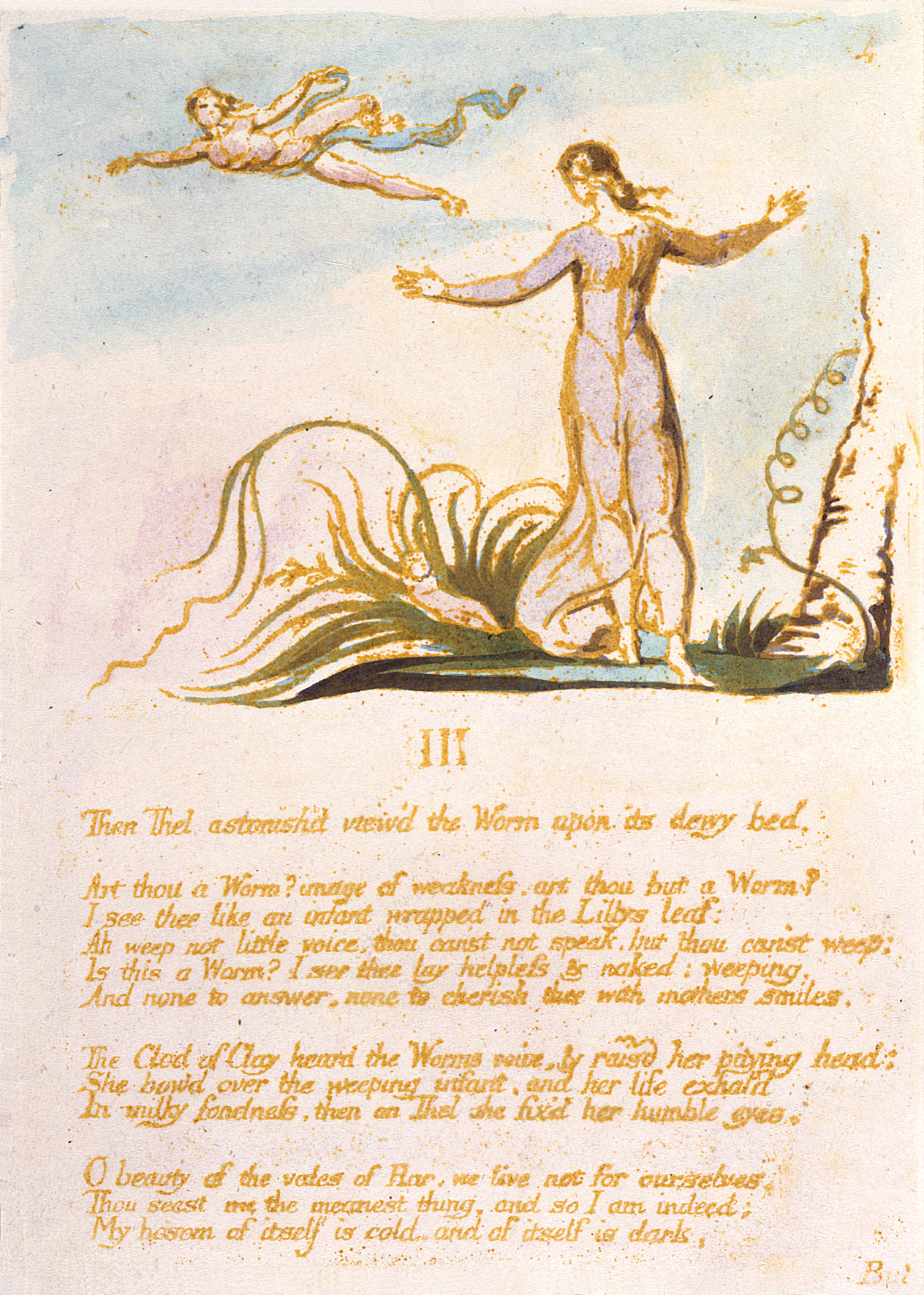
[View this object in the William Blake Archive]
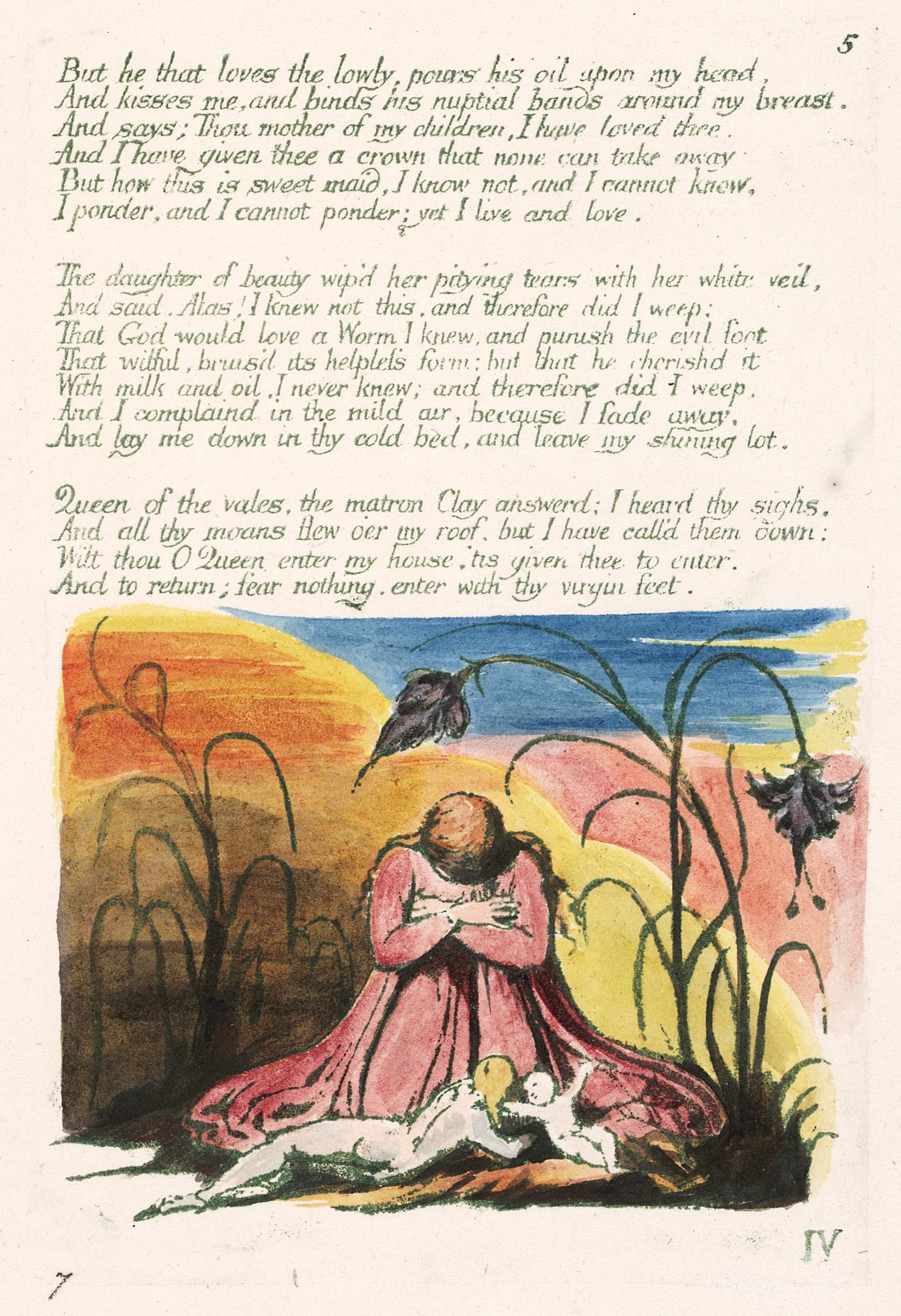
[View this object in the William Blake Archive]
Yet more interestingly, note that the sketch has set out the two pages as a double-page spread, with one design facing the other. Several of Blake’s early works are printed thus on facing pages—for example, Songs of Innocence, Visions of the Daughters of Albion, America, and Europe—but all copies of The Book of Thel are printed on only one side of the leaf; in no printed copy do the first and second pages of Part III face each other, as they do in the sketch. Perhaps Blake decided later that the work, now only eight plates long, would be too short if printed on only four leaves. But in this early sketch he clearly planned for the designs to face one another.
Perhaps most interesting of all is the fact that these two designs are in the reverse order in the printed version of The Book of Thel. Or at any rate, the brooding Thel is printed just after the only design in which Thel stands with outspread arms. We must decide whether the sketch for this standing Thel is another version of the tailpiece to Part II—in which case the text of the poem must then have been quite different than it is now—or whether this is an entirely different design, one which does not survive in The Book of Thel as printed or anywhere else. I rather incline to the latter view; I take the righthand drawing to be a kind of synopsis of the work at its crisis. At this point, Thel has conversed with the Lilly of the valley down by the River Adona, who describes herself as “a watry weed”; with the cloud of air reclining upon his airy throne; and with the baby earthworm, for whom the clod of clay speaks. They clearly represent the elements of water, air, and earth; and the Lilly-woman, Cloud-man, and Worm-baby seem to be represented in this design. In the final words of Part III,
‘Queen of the vales,’ the matron Clay answerd; ‘I heard thy sighs,Thel appears to be on the threshold of the Temple of the Earth, about to enter without fear. She seems to be bidding farewell to her sponsors3↤ 3 Bindman and Butlin call the human figures floating above Thel her “ ‘moans’ ” and “ ‘sighs’ ”, but they seem to be clearly articulated as previously identified figures: the floating figure with raised arms at the upper right looks strikingly like the man who represents “the bright Cloud” on pl. 6, the adult floating above Thel seems to be a woman, presumably the Lilly, and the tiny figure descending towards Thel (in a position related to those of the babes in Urizen pls. 2, 20) must be the infant Worm, the only child previously mentioned. before she turns her back on water, air, and earth, to enter the fire of experience, to participate in the burning element of life. But if so, this design and idea were abandoned when the spaces left in the etched text required Blake to put the tailpiece of Part II in place of the headpiece of Part III (illus. 10) and alter the headpiece of Part III to its tailpiece (illus. 11).
And all thy moans flew o’er my roof, but I have call’d them down:
Wilt thou O Queen enter my house? ‘Tis given thee to enter
And to return; fear nothing; enter with thy virgin feet.’
Why was the design not used? Martin Butlin says the design on the left replaced that on the right, and a new design was substituted on the left “presumably to improve the balance; his new headpiece . . . [for pl. 6] is a lighter, more delicate composition.” David Bindman suggests that “the image of Thel’s house was presumably rejected because its bulk would have broken the delicate rhythm established by the continuity of the appearance of Thel, and the image of the departing cloud in the headpiece of chapter III [Thel pl. 6] gives a central place to the idea of transience.”
Still another motive for abandoning the design of Thel on the threshold of the house is that it is difficult to reconcile with the poetic images which follow, with “eternal gates” closed with a “bar,” with a “dewy grave” and “the hollow pit.” Except for clothes, for Thel’s shepherdess’s crook (pl. 2), for a sword and shield (pl. 3), and for reins (pl. 8), the house in this sketch is the only manmade object in the designs to Thel, and it alters the context of the poem in a disconcerting way. Like the classical building introduced without textual justification in the designs for Tiriel,4↤ 4 Tiriel (1967), pl. I. it introduces a new motif which, in Thel, is distracting and unfortunate.
It has repeatedly been suggested that the last plate of Thel (pl. 8) is a late substitution for an earlier one, because its imagery and tone differ strikingly from those in pls. 1-7.5↤ 5 See D. V. Erdman, “Dating Blake’s Script: the ‘g’ hypothesis,” Blake Newsletter, 3 (1969), 8-13; The Book of Thel, ed. Nancy Bogen (1971), p. 3. I think that the differences on the last plate are deliberately contrived by Blake and are carefully prepared for on the title page and elsewhere. It is at least possible that this penultimate sketch of Thel on the threshold was abandoned because the specific textual images which it illustrated had been abandoned.
The clearly sexual metaphors of The Book of Thel are insufficiently remarked. The “gentle maid,” the “virgin” Thel (ll. 22, 49) encounters an adult “virgin” Lilly (l. 28), an adult male Cloud who is the “partner” of the Lilly of the valley (l. 73), and an “infant” worm (l. 76) who is at least metaphorically their offspring. The “golden” Cloud (l. 47) “scatters its bright beauty” (l. 40) in the same way as the golden Spring “scatter[s his] . . . pearls Upon our love-sick land” (“Spring” in Poetical Sketches, p. 1), both images deliberately evocative of Zeus’s golden shower descending on Danae. This is expressed by the Cloud in a sexual metaphor which Thel does not understand:
O maid I tell thee when I pass away,And when the Cloud leaves Thel, he leaves with her a baby, as in the scene depicted in pl. 6. On the titlepage begin page 140 | ↑ back to top Thel observed sexual courtship, and on the last plate the only humans depicted are babies, the product of such courtship. Thel has been shown the mysteries of sexual life, and in this unused design for the end of Part III we see Thel looking up in wonder at the father Cloud, the mother Lilly, and their offspring the infant Worm. All this is shown to Thel on the threshold of the house of Clay.6↤ 6 Bindman speaks of “Thel’s house,” but I think it is clear that the house is that of Clay. Bindman also calls it “a bulky primitive-classical hut,” but I see no implications of a “hut” in this fairly large, airy building.
It is to tenfold life, to love, to peace and raptures holy. . . .
The weeping virgin trembling kneels before the risen sun
Till we arise link’d in a golden band.
(ll. 52-53, 56-57)
On the last plate, the “dewy grave” picks up images previously used: Thel’s “lamentation falls like morning dew” (l. 5); the cloud “court[s] the fair eyed dew” and unseen descends “upon balmy flowers” (ll. 55, 54) with what the “watry” Lilly calls “morning manna” (ll. 16, 23) (or dew); the worm lies upon a “dewy bed” (l. 74). Thel has asked to be permitted to “sleep the sleep of death” (l. 13) without being “only . . . at death the food of worms” (l. 65), to “lay me down in thy cold bed” of clay without leaving “my shining lot” (l. 98). The classical building in the sketch, even if it be a mausoleum, sorts ill with these images of the “dewy grave.”
What in fact happens in the last Part of Thel? Who is Thel, and where does she go? I think some of the answers may help to explain why this last design was not used.
The Mysteries of The Book of Thel: Thel as Moon Myth; Thel as Moon Mistress
Thel is repeatedly associated with the moon and contrasted with the sun; she lives in reflected light, having no light of her own. As the poem opens, she is distinguished from her sisters who are among their “sunny flocks” (l. 1). Thel is the “virgin of the skies” (l. 67), the “daughter of beauty” with a “white veil” (l. 92) who lives “in paleness” (1. 2) and who “fade[s] away like morning beauty from her mortal day” (l. 3) as the moon does when the sun arises. She continually asks why all things “fade” as “I fade away . . . and leave my shining lot” (ll. 97, 98), and she believes that “all shall say, ‘Without a use this shining woman liv’d’ ” (l. 64), for
Thel is like a faint cloud kindled at the rising sun;Thel is presumably like the Clod of Clay who stresses that “My bosom of itself is cold and of itself is dark” (l. 85). These images are consistent with those of Thel as a moon-goddess; or at least she is clothed with the imagery of the moon.
I vanish from my pearly throne, and who shall find my place?
(ll. 36-37)
She is different in kind from the benevolent, omnipresent god who manifests himself in the sun. The creatures she encounters say they are “visited from heaven” (l. 19) “each morn” (l. 20) by “he that smiles on all” (l. 19), who promises that they shall “be clothed in light” (l. 23). It is possible that this god is an Apollo-figure who drives the chariot of the sun, for we hear of the “golden springs Where Luvah doth renew his horses” (ll. 49-50).
Thel is permitted “to enter [the house of darkness] And to return” (ll. 101-02). What kind of house is it? It is in a “land unknown” (l. 104), but we are told enough of it to draw some interesting conclusions.
The World Beneath the Flat Earth
Thel has, I believe, descended through the earth and emerged on the other side into a world of darkness. To explain what happens requires a short excursion through Blake’s geography. The crucial concept is that the earth is flat.
After about 1783, Blake seems to have distinguished fairly consistently between “the world of imagination” (“the real & eternal World,” Jerusalem, pl. 77, ¶ 1), which is flat, and “the world of generation,” which is round.7↤ 7 Once, in Poetical Sketches (1783), the word Globe is used merely as a neutral synonym for the Earth (“The Couch of Death”), but thereafter “Globe” is used only of the fallen view of the earth. The tyrant Tiriel uses “this globe” as a synonym for “this earth” (Tiriel [?1789], ll. 107, 108). Before Urizen fell, there were no “globes of attraction” (Urizen [1794], pl. 3, l. 36), but because of Urizen “Earth conglob’d” (America [1793] pl. b, l. 7), and Orc says that in Urizen’s universe “Fires inwrap the earthly globe” (America pl. 10, l. 13). In Vala, the fallen world is described as “globes of earth” (p. 123, l. 15); in Milton (1804-[?1808]), Los mistakenly says that “The whole extent of the Globe is explored” (pl. 25, l, 18), and in Jerusalem (1804-[?20]), the fallen Moon “became an Opake Globe far distant clad with moony beams” (pl. 49, l. 20). In a picture for The Divine Comedy of the Goddess Fortune are two circles labeled “Celestial Globe Terrestrial Globe” (p. 1341). As he told Crabb Robinson in 1825, “I do not believe that the world is round. I believe it is quite flat.”8↤ 8 Blake Records (1969), p. 313. Robinson goes on: “I objected the circumnavign[e]—We were called to dinner at the moment and I lost the reply.”
In Vala (?1796-?1807), “The Earth spread forth her table wide” (p. 12, l. 35), and in Milton “the earth [is] one infinite plane” (pl. 14, l. 33). In “The Mental Traveller” is an explanation of how the contrary impression arose:
the Eye altering alters all[;]A more elaborate explanation appears in Milton:
The Senses roll themselves in fear
And the flat Earth becomes a Ball
(ll. 62-64)
every Space that a Man views around his dwelling-place,If the earth is flat like a pancake (not like a cube), it is possible to penetrate the earth with comparative ease and come out on the other side. This is the explanation of what happens in The French Revolution (1791), in The Marriage of Heaven and Hell (?1790-?93)—and in The Book of Thel (1789). In The French Revolution, “the bottoms of the worlds were open’d, and the graves of the arch-angels unseal’d” (l. 301), presumably on the other side of the earth. In The Marriage,
Standing on his own roof, or in his garden on a mount
Of twentyfive cubits in height, such space is his Universe:
And on its verges the Sun rises & sets, the Clouds bow
To meet the flat Earth & the sea . . .
And if he move his dwelling-place, his heavens also move,
Wher’eer he goes. . . .
Such are the Spaces called Earth & such its dimension:
As to that false appearance which appears to the reasoner
As of a globe rolling thro Voidness, it is a delusion. . . .
(pl. 28, ll. 5-9, 12-16)
An Angel . . . took me . . . down the winding cavern . . . till a void boundless as a nether sky begin page 141 | ↑ back to top appeard beneath us, & we held by the roots of trees and hung over this immensity . . . [in] darkness. . . . Beneath us at an immense distance was the sun, black but shining. . . . [When the Angel fled,] this appearance was no more, but I found myself sitting on a pleasant bank beside a river by moon light. . . .
(¶ 61, 63, 65, 67)
This other side of the earth is the land of night and darkness. It is the land, I think, which Thel discovers when she enters the house of clay:
Thel enter’d in & saw the secrets of the land unknown:She enters a land of darkness with “valleys dark” (l. 108) where she hears of “destruction,” “poison,” “ambush,” “terror,” and “the bed of our desire” (ll. 113-22). Terrified at the terrible vision, she “Fled back unhindered till she came into the vales of Har” (l. 124), where she had begun (ll. 4, 26). Like the moon, Thel reflects brightness which fades, and she enters shadows and night. The land she finds is, as it were, in the dark of the moon. Like the moon, Thel returns to light and to reflect light. She ceases to appear, as the moon does when it is completely covered by the shadow of the earth, but she continues to exist though obscured. The images of Thel as a moon goddess are consistent throughout the poem. But the verbal images of Thel entering the earth, entering the house of Clay, and discovering “the fibrous roots” on the other side of the earth are not consistent with the classical building on whose threshold Thel stands in the newly discovered drawing.
She saw the couches of the dead, & where the fibrous roots
Of every heart on earth infixes deep its restless twists. . . .
(ll. 104-106)
It may be that the classical building was consistent with images in a draft of Part IV of The Book of Thel which does not survive; or it may be that Blake made this sketch of a classical building and then recognized its incongruity with the present Part IV. In any case, that massive artifact is distracting in Thel’s pastoral world, and Blake abandoned it in the etched version of the poem. The chance survival of this sketch tells us a great deal about the way in which Blake conceived of and laid out his poem, about the way he carefully planned the relationships of text with design and of page with page. Perhaps most important, it shows us Blake experimenting with the placing of his designs, devising new motifs for his poem and abandoning false starts. We are coming to know Blake as a craftsman of engraving, of painting, and of poetry. This unique design demonstrates graphically the craftsmanship with which he merged these arts in his works in Illuminated Printing.





